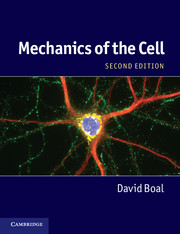Book contents
- Frontmatter
- Contents
- Preface
- List of symbols
- 1 Introduction to the cell
- 2 Soft materials and fluids
- Part I Rods and ropes
- Part II Membranes
- 7 Biomembranes
- 8 Membrane undulations
- 9 Intermembrane and electrostatic forces
- Part III The whole cell
- Appendix A Animal cells and tissues
- Appendix B The cell’s molecular building blocks
- Appendix C Elementary statistical mechanics
- Appendix D Elasticity
- Glossary
- References
- Index
9 - Intermembrane and electrostatic forces
Published online by Cambridge University Press: 05 June 2012
- Frontmatter
- Contents
- Preface
- List of symbols
- 1 Introduction to the cell
- 2 Soft materials and fluids
- Part I Rods and ropes
- Part II Membranes
- 7 Biomembranes
- 8 Membrane undulations
- 9 Intermembrane and electrostatic forces
- Part III The whole cell
- Appendix A Animal cells and tissues
- Appendix B The cell’s molecular building blocks
- Appendix C Elementary statistical mechanics
- Appendix D Elasticity
- Glossary
- References
- Index
Summary
The variety of single cells capable of living independently is truly impressive, from small featureless mycoplasmas just half a micron across, to elegant protists a hundred times that size, perhaps outfitted with tentacles and even a mouth. Organisms such as ourselves, however, are multicellular, emphatically so at 1014cells per human. How do our cells interact, and adhere when appropriate? In this chapter, we investigate intermembrane forces at large and small separations, beginning with a survey of the different features of membrane interactions in Section 9.1. The Poisson–Boltzmann equation, which we derive in Section 9.2, provides our primary framework for treating membrane interactions at non-zero temperature. This approach is applied to the organization of ions near a single charged plate and to the electrostatic pressure between charged walls in Sections 9.2 and 9.3, respectively. Two other contributors to membrane interactions also are treated in some mathematical detail here: the van der Waals attraction between rigid sheets (Section 9.3) and the steric repulsion experienced by undulating membranes (Section 9.4). Lastly, the adhesion of a membrane to a substrate, and its effect on cell shape, is described in Section 9.5. Our presentation of membrane forces is necessarily limited; the reader is referred to Israelachvili (1991) or Safran (1994) for more extensive treatments.
Interactions between membranes
Let’s briefly review the molecular composition of a conventional plasma membrane. Fundamental to a biomembrane is the lipid bilayer, a pair of two-dimensional fluid leaflets described at length in Chapter 7. The lipid composition of the leaflets is inequivalent: in the human red blood cell, one of the best-characterized examples, the phospholipids in the outer leaflet are predominantly cholines, while lipids containing ethanolamine or serine dominate the inner leaflet facing the cytosol (see Appendix B for head-group structures). Cholesterol also may be abundant in the plasma membrane. The head-group of phosphatidylserine, but not the others, is negatively charged, providing a surface charge density ranging up to 0.3 C/m2 if every lipid carries a single charge.
- Type
- Chapter
- Information
- Mechanics of the Cell , pp. 326 - 370Publisher: Cambridge University PressPrint publication year: 2012



